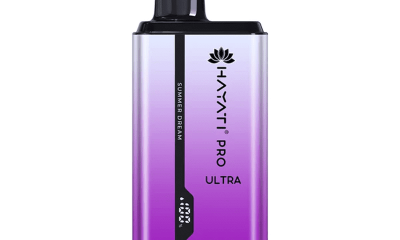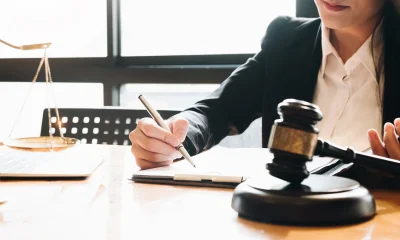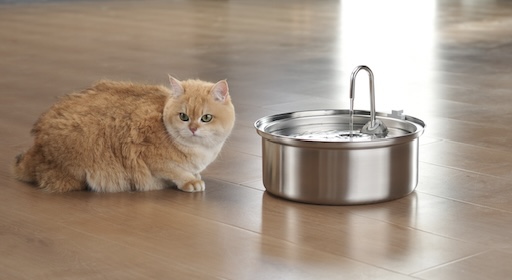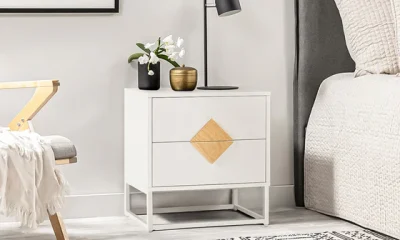Viral
3D Printers in Military: Rapid Manufacturing and Repair of Parts
This is a guest contribution by Egor Driagin, CMO at Top3DGroup
The arrival of 3D printing technology resulted in more questions than answers for the experts and enthusiasts alike. While they are theorizing about printing everyday items on the Moon surface, the American military found ways to utilize 3D printing in real-life conditions. The American military is using portable Expeditionary Lab Mobile (ELM) solutions in conjunction with 3D printers.
The main goals for ELM are: manufacturing single-use tools for military usage and repairing existing equipment. The latter is very important since field usage of equipment often requires some refining. A good example would be a pocket flashlight. They are often defective, which means they can easily break or cause unwanted situations.
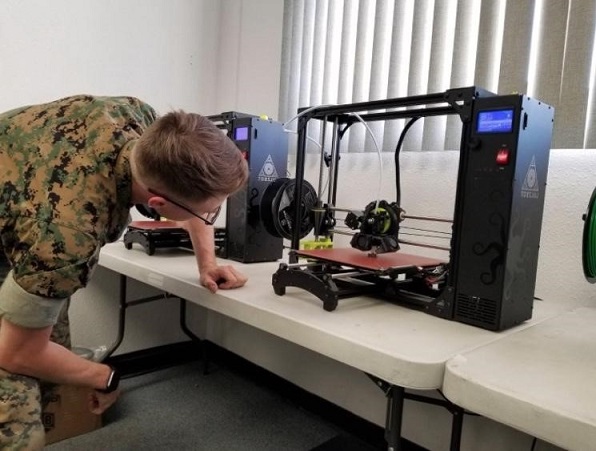
Using 3D Printers on a Battlefield
Being placed in a pocket of a soldier, the flashlight with a defective switch can be turned accidentally turned on and give out its location when it’s least expected. ELM can easily fix the problem of a defective switch. There’s no need to send them back to the US since the switches can be 3D printed on site.
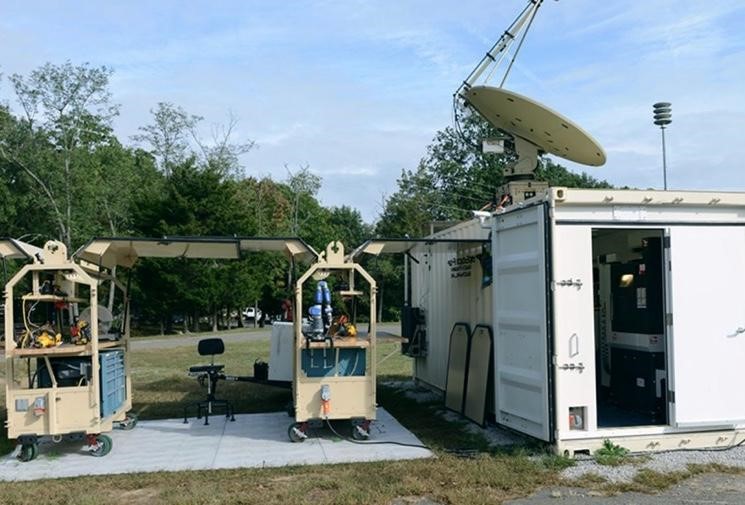

Another example would be a real case when a mine detector sent to Iraq had defects that caused its working time to be reduced threefold. This made the soldiers (that were already on a complicated mission) take several additional heavy batteries with them. Using ELM allowed them to create an adapter that made using other batteries possible and extended the battery life of a device to 9 hours.
ELM Repair Kit with a 3D Printer and Communication System
Expeditionary Lab Mobile is a shipping container (sized 20 x 8 ft or 6,1×2.4 m) of a standard type. A 3D printer and CNC machines can be found inside, the latter of which is used to manufacture complex aluminum and steel parts.


Apart from that, there is also a set of rather traditional tools, such as a cutter, welding machine, router, circular saw, sawzall, and a jigsaw.
ELM includes satellite communication equipment that is important for video conferences. The engineers and officials are supposed to partake in them to control the works when needed. It’s planned that each lab will include 2 engineers and all of them will be connected as a network.
Nevertheless, such a 3D printing system is expensive and costs around $2.8 million. First ELMы will be tested in the Middle East, and if successful, they will be implemented for civil purposes as well. They can be very useful during natural or man-made disasters.
Viral
Should You Choose Open or Closed Cell Spray Foam?


Having your building properly insulated is of utmost importance in this day and age of rising energy costs and increasing environmental concerns. Among the many insulation options available, spray foam stands out, known for its remarkable efficiency and unique properties.
But when diving into the world of polyurethane foam, you are immediately met with a choice: open cell or closed cell? Each comes with its own set of benefits and considerations. Let’s take a closer look.
Spray Foam Insulation: The Basics
Derived from a synthetic polymer blend, spray foam insulation plays a pivotal role in enhancing energy efficiency. It’s widely used to insulate walls, roofs, and other sections of buildings, cutting down those hefty heating and cooling bills. Beyond residential structures, you’ll find it guarding pipes, tanks, and machinery in industrial settings.
So, what makes it so versatile? The answer lies in its creation. By mixing multiple liquid components, including those with heat-insulating agents, this foam offers unparalleled insulation advantages. But not all foams are created equal.
Open Cell Insulation
1. What’s it like?
Open cell foam is softer and more flexible, expanding significantly upon application – up to a whopping 100 times its initial size!
2. Air’s Arch-nemesis:
Boasting a density of 0.4 – 0.6 lbs/cubic foot, it’s a champion in reducing air leaks, which can have a direct impact on indoor air quality.
3. Silence, Please:
If you’re looking to mute those external noises, open cell is your ally. It’s exceptional at dampening sounds and vibrations.
4. Adaptable and Tenacious:
As buildings shift over time, open cell foam remains resilient, enduring seasonal changes without cracking.
5. Easy on the Wallet:
Budget-conscious homeowners rejoice! Open cell insulation is generally more affordable due to its lower installation resource needs.
6. A Few Shortcomings:
It does have a lower R-value (3.5 – 3.9 per inch), so its thermal resistance isn’t as high. Additionally, it doesn’t act as a moisture barrier, which could invite mold or structural damage. And, to safeguard against fire, UV rays, or pests, you’ll need to add extra protective layers.
Closed Cell Insulation
1. What’s it like?
Unlike its open-cell counterpart, closed cell foam is dense and rigid, expanding to depths of about 30-50mm.
2. The Impenetrable Fortress:
With a density of 1.5 – 2 lbs/cubic foot, closed cell acts as both an air and moisture barrier, championing superior thermal resistance.
3. Sturdy and Strong:
One of its crowning glories is the ability to enhance a building’s strength, adhering firmly to the structure.
4. The Price Tag:
Its benefits come at a cost – literally. Closed cell insulation tends to be pricier due to the increased material and labor needs.
5. Impressive Thermal Capacity:
If retaining heat is your primary concern, this foam, with its R-value of 6 – 7 per inch, has got you covered.
6. Barrier Benefits:
Not only does it keep the cold air out, but it’s also a barrier against water, minimizing condensation issues.
7. Built to Last:
Come rain or shine, or the threat of pests, closed cell foam stands firm. However, its rigidity can be both a blessing and a curse. Over time, temperature changes might cause it to shrink and crack.
Final Thoughts
Insulation using polyurethane foam has undeniably revolutionized the world of building insulation. Companies like Isothane are at the forefront, ensuring the quality and efficiency of this material.
When deciding between open and closed cell, consider the specific needs of your project, budget, and long-term goals. Both have their merits, and understanding them can help you make an informed decision, ensuring that your space is comfortable, efficient, and protected for years to come.
For mor information visit https://isothane.com/spray-foam-insulation/
Viral
The Truth About Tattoo Pain: Setting Realistic Expectations for First-Timers


Are you considering getting your first tattoo but worried about the pain? Don’t fret! We’re here to set realistic expectations and ease your concerns.Understanding what tattoo pain feels like, debunking common myths, and knowing which areas hurt the most and the least will help you prepare.Plus, we’ll share tips and techniques to make your experience more comfortable.So, get ready to embark on your tattoo journey with confidence and knowledge.
Understanding the Sensation: What Does Tattoo Pain Feel Like
You might be curious about what tattoo pain actually feels like. Understanding the sensation can help you prepare mentally and physically for your first tattoo.
When it comes to exploring pain tolerance, everyone’s experience is unique. However, most people describe tattoo pain as a combination of discomfort and a sharp, stinging sensation.
It’s important to distinguish between pain and discomfort. Pain is a temporary and manageable sensation, while discomfort can vary depending on factors like tattoo placement and the individual’s pain threshold.
Keep in mind that pain is subjective and what might be painful for one person may be tolerable for another.
Remember to communicate with your tattoo artist throughout the process to ensure your comfort and manage any discomfort that arises.
Factors Affecting Tattoo Pain: Debunking Common Myths
Don’t believe the common myths – factors such as location, size, and your own pain tolerance play a role in how much a tattoo hurts. Additionally, the use of the best numbing cream for tattoos can also influence the perception of pain, helping to reduce discomfort for many.
Let’s debunk some of the myths about tattoo pain and set realistic expectations for first-timers like you who desire mastery in understanding the factors affecting tattoo pain:
- Location: The level of discomfort varies depending on where you get your tattoo. Areas with more nerve endings, such as the ribs or inner thighs, may be more sensitive.
- Size: The size of the tattoo also affects the pain level. Larger tattoos may take longer to complete, causing more discomfort.
- Pain tolerance: Your personal pain tolerance is a significant factor. Some people have a higher pain threshold and can withstand the sensation better than others.
By understanding these factors, you can have a more accurate idea of what to expect when getting a tattoo and make informed decisions.
Tattoo Placement: Which Areas Hurt the Most and the Least
If you’re curious about tattoo placement, it’s helpful to know which areas tend to be more or less painful.
When it comes to pain, everyone’s tolerance is different, but there are certain areas that are generally considered more painful and others that are less painful.
The most painful areas for tattoos are typically those with thinner skin and less muscle, such as the ribs, spine, and ankles. These areas have more nerve endings and can be quite sensitive.
On the other hand, the least painful areas to get tattooed are usually those with more flesh and muscle, like the upper arms, thighs, and buttocks. These areas provide more cushioning and tend to be less sensitive.
Keep in mind that everyone’s pain tolerance is unique, so what might be painful for one person may not be for another.
Managing Tattoo Pain: Tips and Techniques for a More Comfortable Experience
To manage the pain of getting a tattoo, it’s important to communicate with your tattoo artist about any discomfort you may be experiencing. They can provide guidance and support throughout the process. Here are some tips for pain management during a tattoo session:
- Skin numbing creams and sprays: These products can help numb the skin before the tattooing begins. Apply them about an hour before your appointment to help minimize any pain or discomfort.
- Deep breathing and relaxation techniques: Practice deep breathing exercises to help calm your nerves and relax your body during the tattooing process. This can help distract from the pain and make the experience more comfortable.
- Take breaks if needed: If the pain becomes too intense, don’t hesitate to ask your tattoo artist for a short break. This can give you a chance to regroup and manage any discomfort.
Post-Tattoo Pain: What to Expect During the Healing Process
During the healing process, you may experience some soreness and tenderness around the tattooed area. This is completely normal and expected. Your body is working hard to repair the skin and integrate the ink, so some discomfort is to be expected.
The length of the healing time can vary depending on several factors, including the size and location of the tattoo, as well as your personal healing abilities. On average, it takes about two to four weeks for a tattoo to fully heal.
To ensure proper healing, it’s crucial to follow aftercare tips provided by your tattoo artist. These tips may include keeping the tattoo clean and moisturized, avoiding excessive sun exposure, and refraining from picking or scratching the tattooed area. Additionally, it’s important to avoid swimming or soaking in water for at least two weeks to prevent infection.
Conclusion
In conclusion, getting a tattoo may involve some level of pain, but it’s important to set realistic expectations. Understanding the sensation and debunking common myths can help alleviate any anxiety.
Certain areas of the body may be more sensitive than others, but there are various techniques and tips to manage the pain during the process.
Additionally, it’s crucial to take care of the tattoo during the healing process to minimize any post-tattoo pain.
Viral
Turn Your Dreams into Reality with ACE Money Transfer’s Giveaways of 09 iPhones 14 Plus and 03 Honda Click 160 Motorcycles!


Do you wish to break free from the shackles of financial limitations through a process as simple as making a money transfer to Philippines?
Dreams have the ability to motivate and inspire you to achieve your goals. One common goal of all is to achieve financial security. ACE Money Transfer recognises this common priority. Hence, it is dedicated to assisting its users in making their dreams come true.
The leading remittance provider, ACE, is offering three Honda Click 160 motorcycles and nine iPhones 14 Plus alongside absolutely FREE money transfers in a thrilling giveaway promotion. The offer is available until the 31st of August, 2023 for all overseas Filipino workers (OFWs) and expatriates residing across the UK, Europe, Canada, Australia, and Switzerland.
Keep reading this blog to know the details of this appealing promotion, the rewards up for grabs, and how ACE Money Transfer is enabling its users to soar to new heights.
Fulfil Your Dreams Through ACE Money Transfer’s Giveaway Campaign
A Booming Three-Month Campaign
The three-month duration of ACE Money Transfer’s fascinating giveaway promotion gives users plenty of time to take part and realise their ambitions. ACE Money Transfer is giving its devoted users the chance to win expensive rewards but only between June 1 and August 31, 2023.
Any entry after this time period will not be entertained.
Prizes for the Dreamers
Unleash Your Creativity with Nine iPhones 14 Plus.
The revolutionary iPhone 14 Plus is the perfect combination of innovative technology combined with unmatched functionality. This smartphone transforms into a blank canvas for creativity thanks to its classic camera, immersive display, and top-notch features.
ACE will give away nine iPhones 14 Plus to nine lucky winners, providing them with the opportunity to pursue their interests and express themselves in new ways.
Embrace the Freedom of the Open Road with Three Honda Click 160 Motorcycles
The Honda Click 160 motorcycle gives you the experience of a broad road, freedom, and adventure. Three of these stylish, steadfast motorcycles will be rewarded to worthy winners. The freedom to explore that comes with riding a Honda Click 160 Motorcycle allows winners to have lifelong experiences and discover unexplored regions.
How to Enter and Win
All you have to do to enter this amazing promotion is use ACE Money Transfer to send money without paying any transfer fees. Your chances of winning go up automatically with every transaction you make during the campaign period.
Sending money to your family members in the Philippines not only helps them out financially but also opens up a world of opportunities where dreams can come true.
Through this promotion, you can send money to your loved ones at no additional cost. Click here to learn more about free-free transfers.
Nominate a Loved One
ACE Money Transfer supports your loved ones’ aspirations and believes in celebrating relationships. If you win the iPhone 14 Plus, you can choose to nominate a friend, relative, or other special person to get one of these prized gadgets.
Want to learn more about this campaign? Here’s everything for you on this promotion’s Terms & Conditions page.
ACE Money Transfer Never Fails to Go Up and Beyond for Users
Initiatives for Community Empowerment
ACE Money Transfer always tries to empower the Filipino community through these campaigns and promotions. It understands the current economic difficulties of the country, hence promoting the usage of legal channels for sending remittances. 18% of the total Filipino population is living in extreme poverty, and remittances can help improve their lifestyle.
Exclusive Partnerships and Discounts
ACE Money Transfer sometimes offer exclusive partnerships and savings with well-known Philippine companies and firms. ACE Money Transfer rewards its users and improves their whole experience by offering benefits above and beyond the transfer services, further establishing the firm as a reliable and user-focused brand.
Customer Satisfaction is Crucial
For ACE Money Transfer, customer satisfaction and great experiences are the true indicators of success. A great deal of people has left ACE Money Transfer positive testimonials throughout the years.
Why Filipinos Pick ACE as Their Trusted Remittance Partner?
Honesty and Trust
The trust and reliability associated with the firm are among the main factors influencing Filipinos’ decision to use ACE Money Transfer. Users have faith in ACE because of its solid reputation that was developed over many years of great service. Filipinos value the security that comes from knowing that their money will be delivered securely and on time to their loved ones in the Philippines.
Extensive Partner Network
ACE Money Transfer has a wide network of partner banks, remittance agencies, and pickup locations all across the Philippines. No matter where they are, recipients can easily access their funds thanks to this extensive network. ACE Money Transfer makes sure that its services are available to Filipinos countrywide, regardless of whether they are in a busy city or a far-off rural area.
Competitive Exchange Rates and Low Fees
ACE Money Transfer is aware of the need for affordable remittance choices among Filipinos, who are constantly looking for them. When sending money back home, Filipinos may find the firm to be an appealing option because it provides reasonable exchange rates and affordable fees.
ACE Money Transfer helps Filipinos make the most of the financial support they get by giving them value for their hard-earned money.
User-Friendly Platforms and Innovative Technology
ACE Money Transfer proudly utilises the best app interface to improve user experiences. Sending money is simple and convenient due to the user-friendly mobile applications and web platforms. The ease with which ACE Money Transfer’s digital solutions enable them to send money anywhere in the world with just a few clicks is much appreciated by Filipinos.
Commitment to Customer Support
ACE Money Transfer places a high priority on ensuring that users are supported and satisfied. They offer a committed customer support team that is available to answer any questions or address any issues.
The Filipino people respect this individualised assistance and value having a reliable partner to turn to if any problems arise or if help is needed during the remittance process.
Final Thoughts
Do not miss this opportunity to send remittance to your loved ones in the Philippines for free. Who knows, you might actually receive a surprise gift from ACE. Sign up today for free to enjoy unlimited transactions to the Philippines with ease and convenience.
-



 Biography5 years ago
Biography5 years agoJacqulyn Elizabeth Hanley is the Mother of Liza Soberano?
-

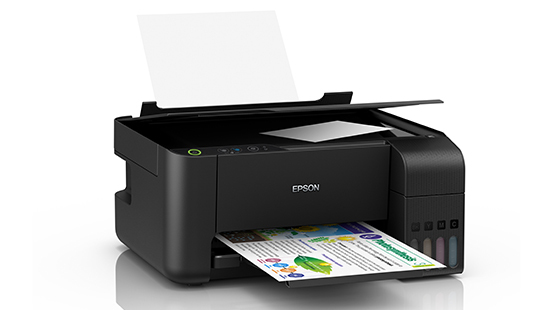

 Home4 years ago
Home4 years agoEpson L3110 Driver Free Download Latest Updated Version
-



 Games3 years ago
Games3 years agoBest Free To Play MMORPG To Try This 2021
-



 Biography5 years ago
Biography5 years agoAmanda Levy Mckeehan Biography, Family, Net Worth, Age, Affairs, Facts
-



 Biography5 years ago
Biography5 years agoWho is Rose Dorothy Dauriac? Scarlett Johansson Daughter?
-



 Biography5 years ago
Biography5 years agoJessica Ditzel Secret Information that Nobody Knows | Joe Rogan’s Wife
-



 Biography5 years ago
Biography5 years agoWhat is the relation of Nathaniel Larry Osorno with Liza Soberano?
-



 Home5 years ago
Home5 years agoLiza Soberano Biography, Age, Family and Boyfriends



